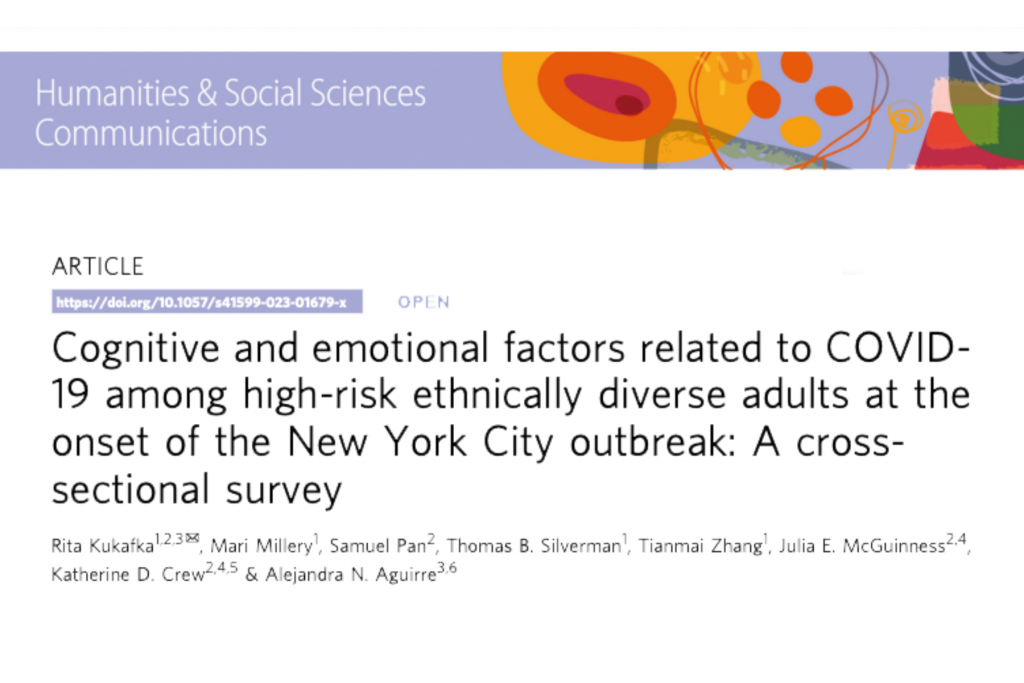Minority Self-Reports Of Added Distress, Anxiety
Could Help Inform Future Pandemic Preparations
Minority respondents in New York City reported higher levels of stress and anxiety in the earliest days of the COVID-19 pandemic than White/non-Hispanic respondents, per a recent study in Humanities and Social Sciences Communications. They were also significantly more likely to report having little control over whether they will get COVID-19 compared with White/non-Hispanic respondents.
These findings suggest the need to develop culturally responsive messaging and interventions during pandemics, according a recent study led by Rita Kukafka, Professor of Biomedical Informatics and Sociomedical Sciences at Columbia University.
“Exploring the effect of race-related differences in exposure to uncertainty as a key source of anxiety and distress in minority
The study, titled “Cognitive and emotional factors related to COVID-19 among high-risk ethnically diverse adults at the onset of the New York City outbreak: A cross-sectional survey” was published May 17 in Humanities and Social Sciences Communications.
populations may lead to programs that pay high attention to the mental health problems evoked by intolerance of uncertainty,” Kukafka wrote. “This type of intervention will likely require the expertise of many disciplines, including mental health experts, to address the emotional and behavioral responses, and communication experts to address the exasperation of uncertainty, particularly among the most vulnerable populations.”
While the majority of early pandemic research focused on the disease itself and potential cures, this study was one of the few that evaluated both cognitive and emotional factors among a racially/ethnically diverse group of residents in New York City, which became one of the early pandemic epicenters. Using a community portal within GetHealthyHeights, a self-described “online community that engages people in Washington Heights-Inwood to connect, discover, and share resources to get healthy” that had been launched five years earlier, the study team was able to assess the real-time threat and coping appraisals within their local community, as well as the levels of distress, anxiety, and intolerance for uncertainty.
“Our study revealed significantly higher levels of intolerance to uncertainty, anxiety, and distress in the minority respondents compared with White/non-Hispanic respondents,” Kukafka wrote. “Whether this heightened IU is due to pre-pandemic elevated uncertainty in the daily life of minority populations or if there are other reasons for differential responses to pandemic uncertainty is an area for continued investigation.”
Intolerance of uncertainty (IU) is comprised of 12 items to assess reactions to impending uncertainty, ambiguous situations, and the future, focusing specifically on both prospective anxiety (the desire for predictability vs. the anxiety about future unknowns) and inhibitory anxiety (behaviorally focused, measuring avoidance and paralysis in uncertain situations).
Minority respondents had significantly higher mean scores on the behaviorally focused aspects of the survey, while both respondents under the age of 65 (as opposed to over 65) and respondents reporting mental health as a comorbidity (as opposed to those who did not report mental health as a comorbidity) had significantly higher mean scores on both IU focuses.
Acquiring and analyzing this data can have important effects on both local and national preparation for future pandemics.
“Understanding mental health, and particularly emotional factors, including heightened anxiety levels, are important to understand,” Kukafka wrote. “Heightened anxiety is found to be associated with a greater chance of carrying out protective behaviors and, therefore, an essential driver of protective behavior during a pandemic. But at the same time, prior research found that coping appraisals combined with anxiety related to the health threat can lead to inappropriate, discriminatory actions, for example, avoidance of individuals of Asian descent in response to the 2003 SARS outbreak and, more recently, during the COVID pandemic. Studies emphasize the need to support people with vulnerability factors, such as heightened anxiety during pandemics, as they seem prone to heightened distress and intensified behavioral responses.”
More Information
The study, titled “Cognitive and emotional factors related to COVID-19 among high-risk ethnically diverse adults at the onset of the New York City outbreak: A cross-sectional survey” was published May 17 in Humanities and Social Sciences Communications.
All authors are from Columbia University: Rita Kukafka, Mari Millery, Samuel Pan, Thomas B. Silverman, Tianmai Zhang, Julia E. McGuinness, Katherine D. Crew, and Alejandra N. Aguirre.



